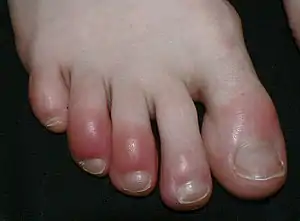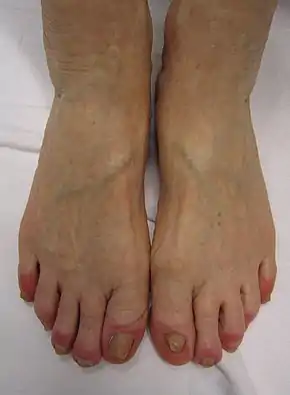Chilblains
Chilblains, also known as pernio, is a medical condition in which damage occurs to capillary beds in the skin, most often in the hands or feet, when blood perfuses into the nearby tissue resulting in redness, itching, inflammation, and possibly blisters.[2] It occurs most frequently when predisposed individuals, predominantly women,[3] are exposed to cold and humidity. Ulcerated chilblains are referred to as kibes. Temperature-related chilblains can be prevented by keeping the feet and hands warm in cold weather and avoiding exposing these areas to extreme temperature changes. Once the diagnosis of chilblains is made, first-line treatment includes avoiding cold, damp environments and wearing gloves and warm socks.[4]
| Chilblains | |
|---|---|
| Other names | Pernio, perniones, perniosis[1] |
 | |
| Toes inflamed by chilblains | |
| Pronunciation |
|
| Specialty | Internal medicine, Podiatry |
Chilblains can be idiopathic (spontaneous and unrelated to another disease), but similar symptoms may also be a manifestation of another serious medical condition that must be investigated. Related medical conditions include Raynaud syndrome, erythromelalgia, frostbite, and trench foot, as well as connective tissue diseases such as lupus or vasculitis. In infants affected by Aicardi–Goutières syndrome (a rare inherited condition which affects the nervous system) chilblain-like symptoms occur together with severe neurologic disturbances and unexplained fevers.
Signs and symptoms

The areas most affected are the toes, fingers, earlobes, nose.
- Blistering of affected area
- Burning and itching sensation in extremities
- Dermatitis in extremities
- Ulceration (severe cases only)
- Erythema (blanchable redness of the skin)
- Pain in affected area
- Skin discoloration, red to dark blue
Chilblains caused by exposure to low temperatures usually heal within 7–14 days.
Prevention
Exposure
Treatment
- Nifedipine and amlodipine, which are vasodilators in the class of drugs known as calcium channel blockers, may help in some cases.[8] Vasodilation may reduce pain, facilitate healing, and prevent recurrences.[9] It is typically available in an oral pill but can be compounded into a topical formula.
- Diltiazem, a vasodilator, may help.[10]
- Apply a mixture of friar's balsam and a weak iodine solution.[6]
History
The medieval Bald's Leechbook recommended treating chilblains with a mixture of eggs, wine, and fennel root.[11] A modern-day home remedy is to put garlic on the chilblains.[12] Neither of these remedies has been supported by scientific research.
COVID-19
Chilblain-like symptoms have also been linked to COVID-19.[13][14][15] COVID toes, as they are commonly known,[16][17][18] have mostly been reported in older children and adolescents,[19][18] who often have not had other symptoms of COVID-19.[20] The symptoms are usually mild and disappear without treatment.[19][18] Their cause is debated: it is uncertain whether COVID toes are a delayed consequence of the viral infection itself or are, at least partially, connected to environmental factors during the COVID-19 pandemic.[16][17][21] They may share some of the microscopic features of chilblains caused by lupus.[20] It has been suggested that in the absence of exposure to cold and damp, COVID-19 should be considered as a possible cause of chilblains.[20]
In a study at the dermatology department of Saint-Louis Hospital in Paris, researchers found that most of their study participants carried high levels of autoantibodies, proteins generated by the immune system that inadvertently attack the body's own tissues. Compared with healthy individuals, the participants showed high activity of proteins called type 1 interferons, which switch on pathogen-fighting genes in immune cells.[22]
References
- James, William D.; Elston, Dirk M.; Treat, James R.; Rosenbach, Misha A.; Neuhaus, Isaac M. (2020). "Dermatoses Resulting From Physical Factors". Andrews' Diseases of the Skin (13th ed.). Elsevier. pp. 18–45. ISBN 9780323547536.
- Cold Stress: Chilblains. National Institute for Occupational Safety and Health. Retrieved January 6, 2009.
- Beuscher, Tara L.; Andrews, Sarah E. (November 2020). "What Are COVID Toes? A Case Study". Journal of Wound, Ostomy & Continence Nursing. 47 (6): 619–621. doi:10.1097/WON.0000000000000711. PMID 33201148. S2CID 226988942.
- Beuscher, Tara L.; Andrews, Sarah E. (November 2020). "What Are COVID Toes? A Case Study". Journal of Wound, Ostomy & Continence Nursing. 47 (6): 619–621. doi:10.1097/WON.0000000000000711. PMID 33201148. S2CID 226988942.
- "By the way, doctor: What can I do about chilblains?". Harvard Health. 1 December 2010. Retrieved 31 May 2020.
- "What are chilblains (pernio)? What causes chilblains?". Medical News Today. 20 December 2017.
- "Chilblains.org – #1 Online Source for Treatments, Prevention, Relief Advice". Chilblains.org.
- Rustin, M.H.A.; Newton, Julia A.; Smith, N.P.; Dowd, Pauline M. (2006). "The treatment of chilblains with nifedipine: the results of a pilot study, a double-blind placebo-controlled randomized study and a long-term open trial". British Journal of Dermatology. 120 (2): 267–75. doi:10.1111/j.1365-2133.1989.tb07792.x. PMID 2647123. S2CID 13230013.
- Simon, T. D.; Soep, JB; Hollister, JR (2005). "Pernio in Pediatrics". Pediatrics. 116 (3): e472–5. doi:10.1542/peds.2004-2681. PMID 16140694.
- Patra, AK; Das, AL; Ramadasan, P (2003). "Diltiazem vs. nifedipine in chilblains: A clinical trial". Indian Journal of Dermatology, Venereology and Leprology. 69 (3): 209–11. PMID 17642888.
- Robert Lacey and Danny Danziger August: The Year 1000: What Life Was Like at the Turn of the First Millennium Little, Brown, 2000 ISBN 0316511579
- "Remedios caseros para sabañones". saludplena.com (in Spanish). Retrieved 29 December 2016.
- Wollina U, Karadağ AS, Rowland-Payne C, Chiriac A, Lotti T (2020). "Cutaneous signs in COVID-19 Patients: a review". Dermatologic Therapy. 33 (5): e13549. doi:10.1111/dth.13549. PMC 7273098. PMID 32390279.
- Young S, Fernandez AP (2020). "Skin manifestations of COVID-19". Cleveland Clinic Journal of Medicine. doi:10.3949/ccjm.87a.ccc031. PMID 32409442.
- Kaya G, Kaya A, Saurat JH (June 2020). "Clinical and histopathological features and potential pathological mechanisms of skin lesions in COVID-19: review of the literature". Dermatopathology. 7 (1): 3–16. doi:10.3390/dermatopathology7010002. PMC 7583593. PMID 32608380.
In acral chilblain-like lesions, a diffuse dense lymphoid infiltrate of the superficial and deep dermis, as well as hypodermis, with a prevalent perivascular pattern and signs of endothelial activation, are observed.
- Massey PR, Jones KM (May 2020). "Going viral: A brief history of chilblain-like skin lesions ("COVID toes") amidst the COVID-19 pandemic". Seminars in Oncology. 47 (5): 330–334. doi:10.1053/j.seminoncol.2020.05.012. PMC 7245293. PMID 32736881.
- Bristow IR, Borthwick AM (June 2020). "The mystery of the COVID toes – turning evidence-based medicine on its head". Journal of Foot and Ankle Research. 13 (1): 38. doi:10.1186/s13047-020-00408-w. PMC 7309429. PMID 32576291.
- Rocha, Kelvin Oliveira; Zanuncio, Virgínia Vinha; Freitas, Brunnella Alcântara Chagas de; Lima, Luciana Moreira (2021). ""COVID toes": A meta-analysis of case and observational studies on clinical, histopathological, and laboratory findings". Pediatric Dermatology. 38 (5): 1143–1149. doi:10.1111/pde.14805. ISSN 1525-1470. PMC 8646534. PMID 34515379.
- Walker DM, Tolentino VR (June 2020). "COVID-19: The impact on pediatric emergency care". Pediatric Emergency Medicine Practice. 17 (Suppl 6-1): 1–27. PMID 32496723.
- Ladha MA, Luca N, Constantinescu C, Naert K, Ramien ML (August 2020). "Approach to chilblains during the COVID-19 pandemic". Journal of Cutaneous Medicine and Surgery. 24 (5): 504–517. doi:10.1177/1203475420937978. PMID 32741218.
- Unusual coronavirus (COVID-19) symptoms: What are they?
- Nicoletta Lanese (2021-10-07). "We might finally know what causes 'COVID toes'". livescience.com. Retrieved 2022-01-08.
External links
- DermAtlas 1683395337
- Cold stress, National Institute for Occupational Safety and Health